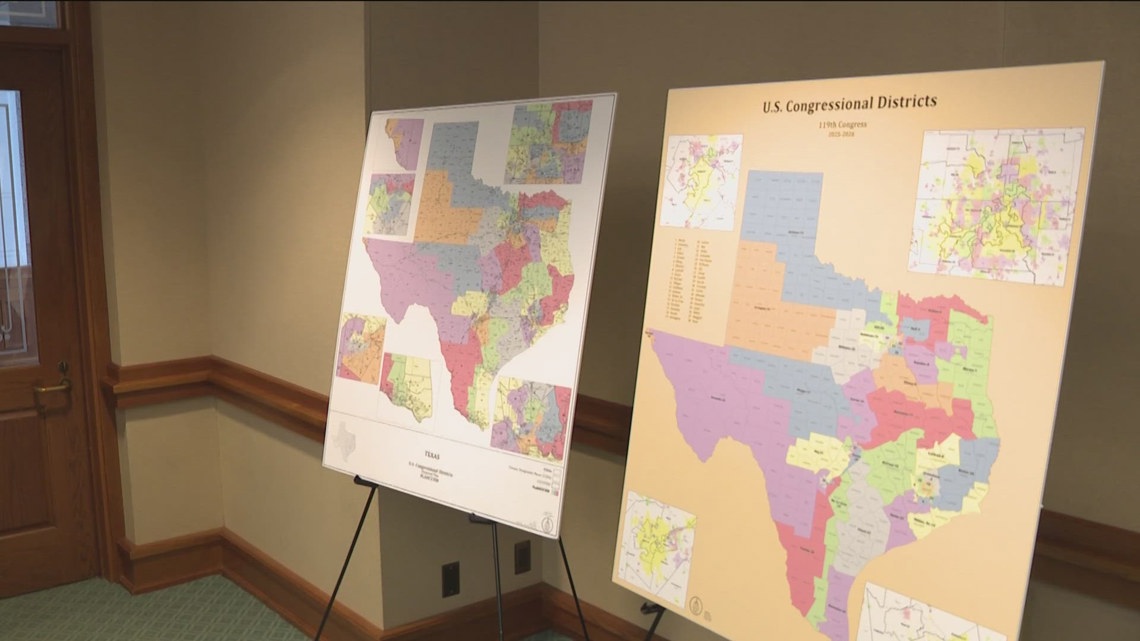
The new map is expected to help Republicans pick up five additional seats in the U.S. House of Representatives.
AUSTIN, Texas — A three-judge panel in El Paso is hearing arguments over the state’s new congressional map.
The trial is the first major test for the new map, which was passed during the second special session. Organizations, including the League of United Latin American Citizens, sued over the Republican-led mid-decade redistricting, arguing the new map is unconstitutional.
The new map is expected to help Republicans pick up five additional seats in the U.S. House of Representatives. The push to redraw the congressional district map came after heavy urging from President Donald Trump.
The groups that are suing argue that the map strips power from black and Latino voters. They say the map is a racial gerrymander, which is prohibited by the 1965 Voting Rights Act and the U.S. Constitution, and are asking the court to issue a preliminary injunction to stop the state from using the new map in the 2026 midterm elections.
“The claims under the Voting Rights Act turn on the consequences of the new map, how it actually affects the voting power of minority communities,” David Froomkin, an Assistant Professor at the University of Houston Law Center, said. “The racial gerrymandering issue, on the other hand, turns on the intent that state officials had in designing the new map.”
Texas Republicans have stated that they believe the map is legal and that it was drawn with the intention of winning more GOP seats, without regard for racial considerations. Drawing districts for partisan gain or political advantage is legally permitted under prior Supreme Court rulings.
“They’re arguing exactly what it is wise for them to be arguing,” Froomkin said. “The question is whether a court will be persuaded that the goal all along was a partisan goal, just because they’re saying it now.”
The hearing is expected to run through next Friday. A mix of Democratic and Republican presidents appointed the federal judges on the panel. Barack Obama appointed senior U.S. District Judge David Guaderrama from the Western District of Texas, 5th Circuit Court of Appeals Judge Jerry E. Smith was appointed by President Ronald Reagan and President Trump appointed U.S. District Judge Jeffrey Brown of the Southern District of Texas.
The same groups are also suing over the 2021 state legislative and congressional maps, arguing that those maps also discriminate against some Black and Latino voters.
Froomkin said it’s usually hard to prove maps were drawn to disenfranchise minority voters.
“Legislators are reluctant to say when their motive was a racial one, typically,” Froomkin said. “Here, in a quite unusual case, they actually did say, at least at an early stage of the process, that race was the predominant motive for pursuing this redistricting plan. So in many ways, that makes this an easier case.”
In July, state Republican leaders cited a letter from the U.S. Department of Justice as justification for redrawing new boundaries. That letter said some of the current districts were drawn based on race. Since then, Republicans have backed off that argument. However, Democrats point to the letter as evidence of unconstitutional racial motivation.
In the letter, the DOJ said four Democrat-held districts constitute “unconstitutional racial gerrymanders, in violation of the Fourteenth Amendment and the Voting Rights Act.”
By breaking up the majority non-white districts, the plaintiffs argue it dilutes the voting power of Black and Hispanic Texans.
“It’s also clear that it generally operates in a way that’s consistent with the rationale that the DOJ letter laid out,” Froomkin said. “The districts that are targeted for changes in their racial composition under the new plan generally are the very same districts that the DOJ letter identified as districts that had a problematic racial composition. So I think that that’s something the plaintiffs will point to.”
In a motion filed late last month, the Office of the Texas Attorney General wrote that it was not illegal racial gerrymandering but part of a political arms race. In response to Texas’s new map, California could redraw its congressional districts to help Democrats pick up more seats there. Voters there would have to approve that effort this November. Last month, Missouri redrew its map to add one more Republican seat, although that map is also facing legal challenges.
“For decades, Democrat-run states have engaged in extreme partisan gerrymandering to maximize their political advantage. Their Republican-led corollaries are fed up with these games and now plan to fight fire with fire,” the AG’s office wrote in a court filing.
Even though the governor stated in interviews that the letter was a factor in his decision to add redistricting to the special session agenda, lawyers for the state argued that it is not relevant and did not play a role in the redistricting process.
“It’s hard for them to take the position that this map was always about partisanship. When they initially said it was about race,” Froomkin said. “They make clear that the initial understanding of the objective of this redistricting effort was changing the racial dynamics of the map. That’s quite unusual.”
The Trump administration sought to have Texas redraw its maps to create more Republican-leaning districts, thereby increasing the GOP’s advantage in the U.S. House, which they currently control by a slim margin of 220-212. The goal is to make it easier for Republicans to maintain control of the House in the upcoming 2026 midterm election, when the party could face significant political headwinds.
Based on the proposed new map, President Trump would have won 30 of the state’s 38 congressional districts in the 2024 presidential election by at least 10 percentage points.
Under the proposed map, 24 districts would comprise a majority of white residents who are eligible to vote, an increase of two from the current map. The map would add one Hispanic-majority district, bringing the total to 8, and create two new majority-black districts.
Four out of the five districts that Republicans are hoping to flip are majority Hispanic.
While Republicans point out the proposed map doesn’t racially gerrymander and adds districts that are majority Hispanic and Black, the plaintiffs argued it is “window dressing” to make it look like it is helping voters of color, while actually diminishing their ability to elect their candidate of choice. Because the majority is so slim, white voters, who generally turn out in larger percentages, can control election results.
On Wednesday, the judges heard from two witnesses, Democratic State Sen. Carol Alvarado from Houston and Democratic State Rep. Joe Moody from El Paso.
Alvarado told the court the redistricting process during the special session was unusual. She said redistricting was never discussed in the regular session and that it was only discussed after the DOJ sent a letter to Gov. Abbott and Texas Attorney General Ken Paxton, calling the coalition districts unconstitutional.
She said there were four public hearings held, which she considered insufficient, and the public was overwhelmingly opposed to a new map.
Rep. Moody echoed that sentiment, saying it is “not built to give Hispanics or African Americans a candidate of their choice.”
Both Moody and Alvarado said there wasn’t a much transparency on things like who drew the map. Republican leaders sidestepped those questions during hearings, with Rep. Todd Hunter (R-Corpus Christi), who carried the map in the House, stating that he had worked with the Butler Snow law firm but did not know which consultants they used.
The widespread belief is that the National Republican Redistricting Trust was involved in drawing the new map, which is the same group helped with the current map.
During a hearing, State Sen. Phil King (R-Weatherford) revealed that he had spoken to the group’s leader, Adam Kincaid, multiple times in recent months, but asked him not to share any information about map drawing or the details of any map if he was involved in it.
The state is expected to call Kincaid to testify as a witness next week. Other state legislators are expected to testify on behalf of the plaintiffs over the next few days, before the state presents its witnesses.
If the court issues a preliminary injunction, one likely option is that the court will keep the 2021 congressional map in place for the 2026 midterm races.
With the same group suing the state now also suing over the 2021 map, Froomkin said the court could also rule on both cases.
“It’s quite possible that the upshot of this litigation would be a court ordering a remedial map, saying even the preexisting map had flaws, either due to a violation of the Voting Rights Act or the Constitution, in which case the court could order that a new map be drawn,” Froomkin said.
It is not clear when the judges plan to rule on the case, but the clock is ticking. The filing deadline for candidates running in the 2026 primary is Dec. 8.
